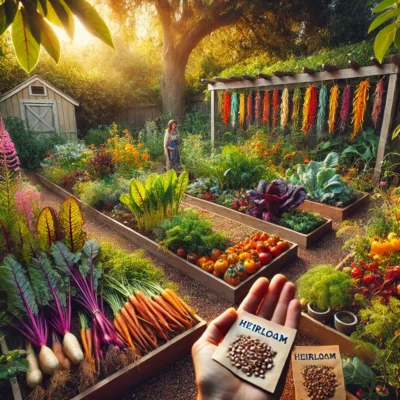
Why Heirloom Seeds Might Just Save Your Garden—and Your Health
In an age of industrial agriculture, fast-growing hybrids, and genetically tweaked produce, a quiet revolution is taking root in backyard gardens and small farms across the country.
Heirloom seeds—those open-pollinated varieties passed down through generations—are reclaiming their place in the soil, offering something far more valuable than convenience: flavor, nutrition, biodiversity, and food sovereignty.
What Are Heirloom Seeds, Really?
Heirloom seeds are typically defined as plant varieties that have been passed down for at least 50 years, preserved and shared within communities, families, and small farms. Unlike hybrid seeds, which are the result of deliberate cross-breeding for traits like uniform appearance or transportability, heirlooms are open-pollinated. This means they rely on natural mechanisms—like wind, insects, or hand-pollination—to reproduce true to type.
That one trait opens a world of possibilities for home gardeners and small-scale growers. When you plant heirlooms, you’re not just growing vegetables—you’re growing next year’s seeds.
Saving Seeds, Saving the Future
One of the most practical advantages of heirloom seeds is seed-saving. Hybrid seeds, by design, don’t reliably produce plants with the same traits as the parent. That forces gardeners and farmers to buy new seed each year. Heirlooms, on the other hand, can be saved season after season, becoming increasingly adapted to your unique soil, climate, and growing conditions.
This isn’t just convenient—it’s a form of agricultural resilience. As climate conditions shift and supply chains falter, being able to rely on your own seed supply becomes a powerful act of self-sufficiency. Heirlooms, with their diverse genetics, tend to be more adaptable to changing environments than hybrids bred for monoculture systems.
Nutrition: More Than Just a Buzzword
Modern hybrid vegetables are often bred for size, shelf life, and appearance—not for nutrient density. That trade-off has consequences.
A landmark study from the University of Texas at Austin in 2004 found that 43 different garden crops showed “statistically reliable declines” in protein, calcium, phosphorus, iron, riboflavin, and vitamin C between 1950 and 1999. Researchers concluded that this decline was likely due to the selection of high-yielding varieties that diluted nutrient content.
In contrast, many heirloom varieties have been preserved precisely because of their robust flavors and nutritional qualities. A tomato that’s been saved for 100 years probably wasn’t chosen because it looked good on a truck—it was chosen because it tasted like summer and nourished the family who grew it.
Other studies have backed up this claim. For example, a 2018 study in Crop Science found that older varieties of corn had significantly higher concentrations of certain antioxidants compared to modern hybrids. Similar results have been found in older carrot and bean varieties. While more large-scale research is needed, the data we do have is compelling.
Flavor You Can’t Fake
Ask any gardener who has bitten into a Brandywine tomato or a Moon & Stars watermelon: there’s just no comparison. Heirloom vegetables are often more flavorful than their hybrid counterparts. That’s because, historically, seeds were saved not for how they looked in a supermarket bin, but for how they tasted at the dinner table.
Hybrids are often bred to ripen uniformly or resist bruising during shipping. But heirlooms? They’re bred for flavor, tradition, and performance in the garden, not the warehouse. That means richer, more complex taste profiles, and a deeper connection to the food on your plate.

By growing heirlooms, you’re actively participating in the conservation of rare and endangered plant varieties.
Biodiversity in Every Row
Industrial agriculture relies on a surprisingly small number of plant varieties. This genetic narrowing makes the global food system dangerously vulnerable to pests, disease, and climate extremes. Heirloom seeds preserve a staggering range of genetic diversity that has been mostly bred out of commercial hybrids.
Each heirloom plant is like a living archive of genetic material, adapted to different regions, soils, and weather conditions. This biodiversity isn’t just about aesthetics—it’s insurance for the future of food.
By growing heirlooms, you’re actively participating in the conservation of rare and endangered plant varieties. You’re preserving the stories, flavors, and survival strategies of plants that have fed generations.
A Radical Act of Reconnection
Growing heirloom seeds is more than a gardening choice—it’s a cultural and ecological stand. It’s a rejection of disposable agriculture, and a step toward sustainable, nutrient-rich, and regenerative gardening. It’s a way to nourish your family with vegetables that actually taste like food, packed with the nutrients your body craves.
It’s also a deeply human act. Many heirloom varieties come with stories—of immigrants carrying seeds in their coat pockets, of communities passing down seeds as family heirlooms, of gardeners naming varieties after their children. When you plant an heirloom seed, you’re continuing a story.
The Garden Revolution Starts With a Seed
If you’re looking for one simple change that can transform your garden and your health, start with heirloom seeds. They offer superior nutrition, unmatched flavor, and the power to regenerate themselves year after year.
In a world of instant fixes and factory-farmed food, heirloom seeds offer something refreshingly real. They’re not just relics of the past—they may be the key to a healthier, more sustainable future.
 Off The Grid News Better Ideas For Off The Grid Living
Off The Grid News Better Ideas For Off The Grid Living




